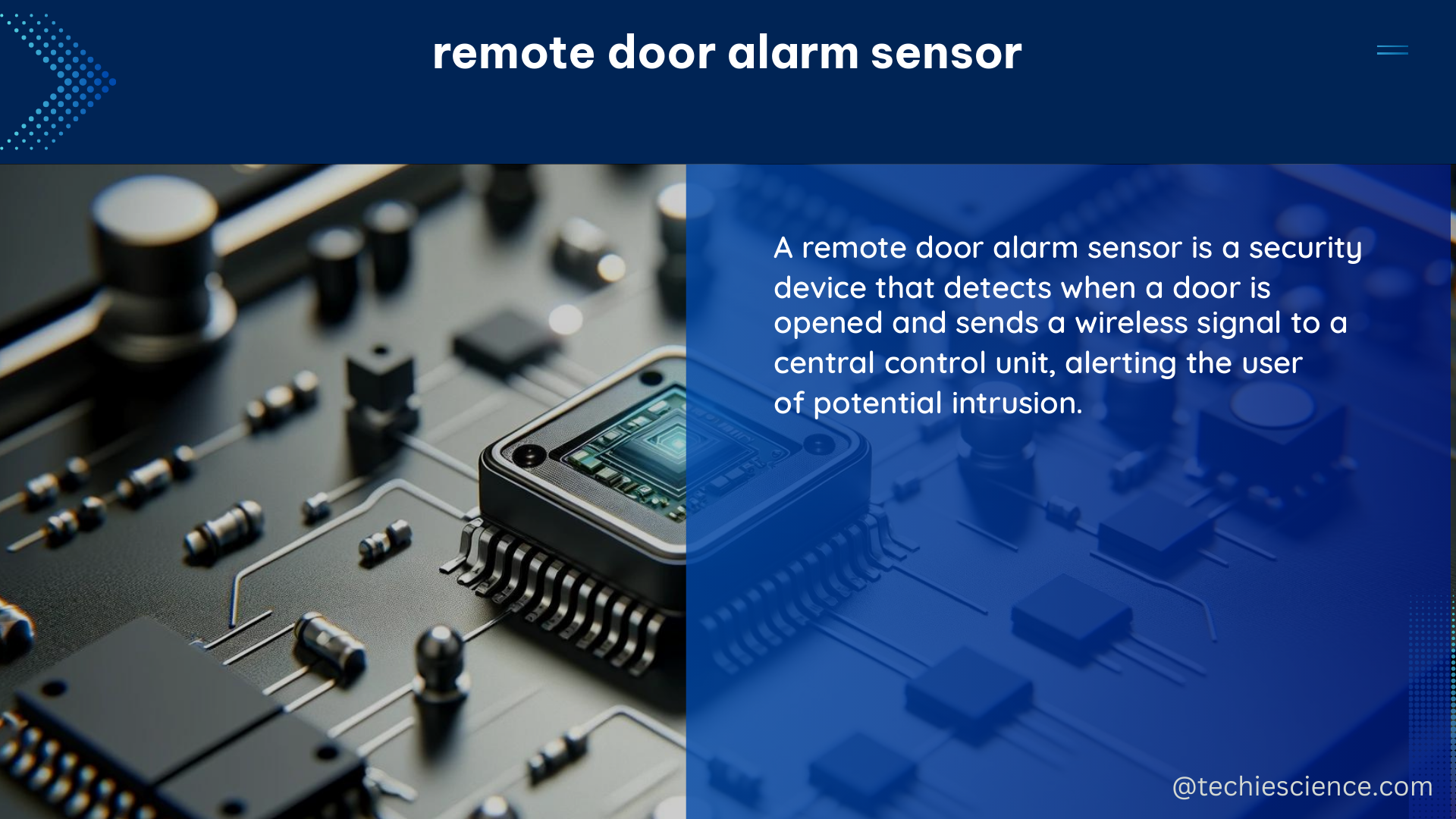Remote door alarm sensors are a crucial component of modern home security systems, providing a reliable and efficient way to detect unauthorized access and protect your property. These sensors are designed to monitor the opening and closing of doors, triggering an alarm when a breach is detected. In this comprehensive guide, we’ll dive deep into the world of remote door alarm sensors, exploring their technical specifications, installation, and customization options to help you create a robust and personalized home security solution.
Understanding the Anatomy of Remote Door Alarm Sensors
Remote door alarm sensors typically consist of two main components: a magnet and a sensor. The magnet is attached to the door, while the sensor is mounted on the door frame. When the door is closed, the magnet is in close proximity to the sensor, creating a closed circuit. When the door is opened, the magnet moves away from the sensor, breaking the circuit and triggering the alarm.
The sensor itself is a sophisticated electronic device that can detect the presence or absence of the magnet, and it is often equipped with additional features such as motion detection, temperature monitoring, and wireless connectivity. The sensor’s sensitivity and range can vary depending on the manufacturer and model, with some offering advanced capabilities like adjustable sensitivity and customizable alarm settings.
Exploring the Amcrest SmartHome WiFi Door Alarm System

One of the leading examples of a remote door alarm sensor system is the Amcrest SmartHome WiFi Door Alarm System. This comprehensive solution includes a central hub, a PIR motion sensor, and two window/door sensors, all designed to work seamlessly together to provide a robust home security system.
Technical Specifications of the Amcrest SmartHome WiFi Door Alarm System
- CPU: A7 @ 900MHz
- Wireless Connectivity: Wi-Fi only
- Communication Distance: 328 feet in an open field
- Motion Sensor Detection Distance: 26 feet with a detection angle of 110°
- Power Supply: DC5V, 1A
- Working Environment: 14°F ~ 131°F (-10°C ~ +55°C)
- Hub Dimensions: 2.95 x 0.94 inches
- Hub Weight: 0.10 lbs
- Mounting Options: Wall-mountable or desktop placement
Customization and Expandability
The Amcrest SmartHome WiFi Door Alarm System is designed to be a highly customizable and expandable solution. It supports up to 32 door/window sensors and PIR motion sensors, allowing you to tailor the system to your specific home layout and security needs. Additionally, the system features voice prompts and a 2-way communication mechanism, enhancing the user experience and providing real-time feedback on the system’s status.
Building Your Own Remote Door Alarm Sensor
For those interested in a more hands-on approach, there are resources available online that provide step-by-step guides on how to build your own remote door alarm sensor. One such resource is the Micro:bit Activity – Make a Door Alarm! video on YouTube, which demonstrates the process of creating a door alarm using a micro:bit, a small programmable computer.
The video references a detailed document that outlines the necessary components, wiring diagrams, and programming instructions to construct a functional door alarm. This DIY approach allows for a high degree of customization and personalization, enabling you to tailor the sensor to your specific requirements and preferences.
Key Considerations for Choosing a Remote Door Alarm Sensor
When selecting a remote door alarm sensor, there are several important factors to consider:
- Sensor Sensitivity: Ensure the sensor’s sensitivity is appropriate for your needs, as it will determine the accuracy and responsiveness of the alarm system.
- Wireless Connectivity: Look for sensors with reliable wireless connectivity, such as Wi-Fi or Bluetooth, to simplify installation and minimize wiring.
- Range and Coverage: Evaluate the sensor’s communication distance and detection range to ensure it can effectively monitor your desired areas.
- Power Supply: Consider the power source, whether it’s battery-powered or requires a dedicated power adapter, and factor in the system’s energy efficiency.
- Compatibility and Expandability: Opt for a system that is compatible with other smart home devices and can be easily expanded to accommodate your growing security needs.
- User-Friendly Interface: Prioritize sensors with intuitive mobile apps or control panels, making it easy to monitor and manage your home security system.
- Environmental Considerations: Ensure the sensor can operate reliably within your local climate and temperature range.
By carefully considering these factors, you can select a remote door alarm sensor that not only meets your current security requirements but also provides a scalable and future-proof solution for your home.
Conclusion
Remote door alarm sensors are a crucial component of modern home security systems, offering a reliable and efficient way to detect unauthorized access and protect your property. Whether you choose a pre-built solution like the Amcrest SmartHome WiFi Door Alarm System or opt for a DIY approach, understanding the technical specifications, customization options, and key considerations can help you create a personalized and robust home security solution that meets your unique needs.
References:
- Sensors for daily life: A review – ScienceDirect.com
- An Approach for Representing Sensor Data to Validate Alerts in Ambient Assisted Living
- Micro:bit Activity – Make a Door Alarm! – YouTube
- Amcrest SmartHome WiFi Door Alarm System Phone app Alert AL-KIT1-PP
- It’s 2023 and you have to buy door sensors, what’s your choice? – Reddit

The lambdageeks.com Core SME Team is a group of experienced subject matter experts from diverse scientific and technical fields including Physics, Chemistry, Technology,Electronics & Electrical Engineering, Automotive, Mechanical Engineering. Our team collaborates to create high-quality, well-researched articles on a wide range of science and technology topics for the lambdageeks.com website.
All Our Senior SME are having more than 7 Years of experience in the respective fields . They are either Working Industry Professionals or assocaited With different Universities. Refer Our Authors Page to get to know About our Core SMEs.